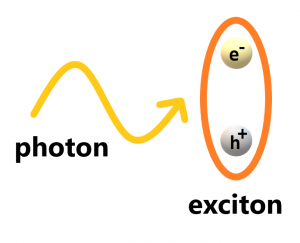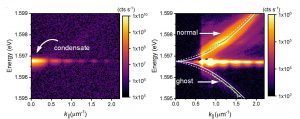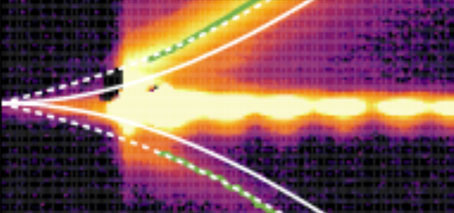Australian research collaboration makes first detection of ‘ghost particles’ from Bose-Einstein condensates made of light and matter.
The ANU/Monash University collaboration study:
- Observed ‘quantum depletion’ for the first time in a non-equilibrium condensate
- Discovered that ‘light-like’ condensates don’t behave as we would expect
- Observed ‘ghost’ excitations arising from quantum depletion for the first time.
Quantum depletion observed for the first time

Superfluid: quantum state in which particles flow without resistance to their motion.
Bose-Einstein condensate: quantum state occurring at ultra-cold temperatures.
Bose-condensed quantum fluids are not forever.
Such states include superfluids and Bose-Einstein condensates (BECs).
There is a beautiful purity in such exotic states, in which every particle is in the same quantum state, allowing quantum effects to be seen at a macroscopic level visible on a simple microscope.
In reality though, not all particles stay in the condensate even at absolute zero where, classically, particles are expected to stand still. Instead, interaction-induced quantum fluctuations make the particles collide, unavoidably expelling some particles out of the condensate, a phenomenon called “quantum depletion”.
This effect is incredibly strong in superfluid helium-4, the first known superfluid, such that 90% of the particles are expelled out of the condensate. However, in extremely dilute, ultracold atomic gases, which form the typical Bose-Einstein condensates (BEC) we know, the effect is much weaker, almost negligible.

Lead author, FLEET Research Fellow Dr Maciej Pieczarka studies dynamical condensation and phase transitions of exciton-polariton fluids created in semiconductor microcavities.
Although quantum depletion has been well described theoretically (by the 70-year-old theory developed by Nikolay Bogoliubov), it has historically known to be difficult to measure in an atomic BEC for a number of reasons.
Instead of atomic particles, physicists at the Australian National University (ANU) use exciton-polaritons, hybrid particles with both light and matter character, which allows detection of momentum without any distortion.
The ANU team, led by Prof Elena Ostrovskaya, successfully detected the expelled particles by blocking the light, using a razor edge, emitted by the incredibly bright condensate. “It is like recreating a solar eclipse,” says the study’s lead author Dr Maciej Pieczarka. “The moon blocks the bright sun (the condensate) and exposes its glorious corona (the excitations).”
The study represents the first direct observation of quantum depletion in a non-equilibrium Bose-Einstein condensate (BEC).
‘Light-like’ condensates don’t behave as we would expect. In fact, there is no explanation for this behaviour

Exciton polariton: a hybrid particle composed of a photon (light) and an exciton (a bound electron-hole pair)
A surprising result of the study offers a new challenge for the physics of nonequilibrium quantum fluids. Exciton-polariton condensates can be tuned from more matter-like (excitonic) to more light-like (photonic), allowing for comparison with theories of equilibrium atomic (matter) condensate and of nonequilibrium quantum fluids of light.
The researchers found that when condensates were ‘matter-like’, they behaved precisely as expected for a BEC in thermal equilibrium (described by the long-standing Bogoliubov theory).
However, condensates that were ‘light like’ deviated from expected Bogoliubov behaviour, in a manner not described by any existing theories
In short, even if these condensates are driven-dissipative, they can behave like atomic condensates in equilibrium (when they are matter-like) or a non-equilibrium quantum fluid (when they are light-like).
Negative excitation observed

Left: momentum-space luminescence of the strong signal from the high-density condensate. Right: same data taken with a razor-edge filter covering the signal from the condensate, revealing the normal and ghost excitations of the condensate.
The research resolves a long-standing problem in exciton-polariton condensates: the problem of visibility of excitation branches.
Quantum depletion leads to visibility of ‘ghost’ branches in the spectrum of excitations. Previously, only the positive or normal excitations had ever been observed in a spontaneously created, steady-state BEC, while the negative or ghost excitations predicted by Bogoliubov eluded observations in this regime.
Now, the ANU team used the interaction-dominated high-density condensates, in the steady-state regime, to increases the very weak signal from the ghost particles. This study demonstrates the first clear experimental observation of this ghost branch of elementary excitations in a spontaneously created, steady-state exciton-polariton condensate.
Unlike its normal counterpart, the ghost particles can only be created by quantum fluctuations and their detection in this study is the smoking gun of the quantum depletion of exciton-polariton condensates.
“The ironic thing about these expelled particles is that even though they are strictly not part of the condensate, they actually tell you almost everything about the depleted condensate,” says co-author Dr Eliezer Estrecho.
The ANU-led team used the observation of the ghost branch to accurately measure the strength of interactions of exciton-polaritons, a key parameter that had a controversially large uncertainty based on other groups’ measurements. The result is in full agreement with previous work by the ANU team (see below), where the high-density, interaction-dominated condensate was serendipitously combined with the hole burning effect. Excellent agreement with theory has finally settled the controversy.
Superfluids and quantum condensates

Bosons: fundamental particles that can occupy the same quantum state, so that a condensate of bosons behaves as a single quantum particle.
Superfluids, such as Helium-4, are closely related to Bose-Einstein condensates (BEC) of interacting bosons.
‘Quantum depletion’ describes the process by which, even at Absolute Zero, some of the particles that occupy the macroscopic quantum state become excited into higher momentum states via interparticle interactions and quantum fluctuations.
Essentially, such particles are ‘expelled’ out of the condensate.
Quantum depletion is particularly difficult to measure in non-equilibrium systems such as exciton-polariton condensates (photons coupled to electron-hole pairs in a semiconductor) since there are other processes that can produce the same expelling effect
In the new study, quantum depletion of an optically- trapped high-density exciton-polariton condensate is observed by directly detecting the process’s telltale signature of the ghost particles occupying the negative branch of elementary excitations.
“The results call for a deeper understanding of the relationship between equilibrium and nonequilibrium BECs,” says Prof Elena Ostrovskaya.
The team, which includes theory collaborators within the Monash University node of FLEET, is now extending their work to elucidate deeper underlying properties, like the phases and universal relations, of this light-matter hybrid of a condensate.
The study
‘Observation of quantum depletion in a nonequilibrium exciton-polariton condensate’ was published in Nature Communication in January.
Experimental work was conducted at the Polariton BEC Research Group at ANU (led by FLEET CI Prof Elena Ostrovskaya), while theoretical studies were conducted by Theory of Quantum Matter group at Monash University (led by FLEET CI A/Prof Meera Parish and FLEET AI Dr Jesper Levinsen).
Funding was provided by the Australian Research Council (Centres of Excellence program) and the authors also thank Ryo Hanai (Osaka University) for useful discussions.
Previous works related to the interaction strength measurement.
- Direct measurement of polariton-polariton interaction strength in the Thomas-Fermi regime of exciton-polariton condensation, Physical Review B, 2019
- Effect of optically-induced potential on the energy of trapped exciton-polaritons below the condensation threshold, Physical Review B, 2019
Non-equilibrium physics and superfluidity at FLEET
 Prof Ostrovskaya’s group at ANU and A/Prof Parish’s group at Monash University seek understanding and control of non-equilibrium quantum systems.
Prof Ostrovskaya’s group at ANU and A/Prof Parish’s group at Monash University seek understanding and control of non-equilibrium quantum systems.
Non-equilibrium physics, studying systems ‘forced’ out of equilibrium into a temporary state, is a relatively new, and exciting field of physics, and a paradigm shift in material engineering and fundamental physics.
At FLEET, non-equilibrium mechanisms governing the behaviour of exciton-polariton condensates and superfluids are pursued by researchers in FLEET’s Research Theme 2 (led by Prof Ostrovskaya), with the aim of achieving zero-resistance paths for electrical current, as part of the Centre’s mission to develop a new generation of ultra-low energy electronics.
FLEET is an Australian Research Council-funded research centre bringing together over a hundred Australian and international experts to develop a new generation of ultra-low energy electronics.
More information
- Contact Dr Maciej Pieczarka Maciej.Pieczarka@anu.edu.au
- Contact Prof Elena Ostrovskaya elena.ostrovskaya@anu.edu.au
- Visit Polariton BEC Research Group at ANU polaritonbec.org
- Visit FLEET.org.au
- Watch Future solutions to computation energy use
- Connect @FLEETCentre



